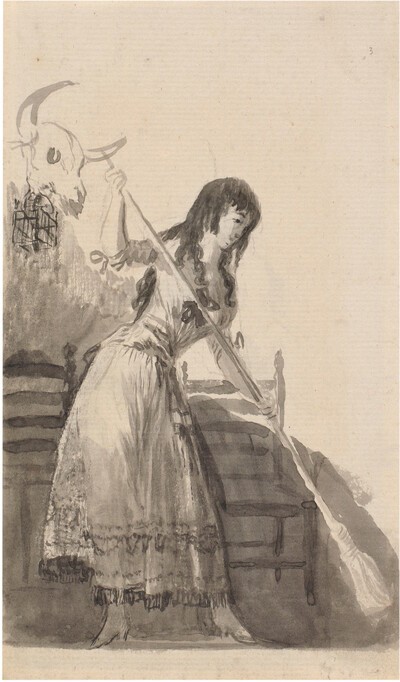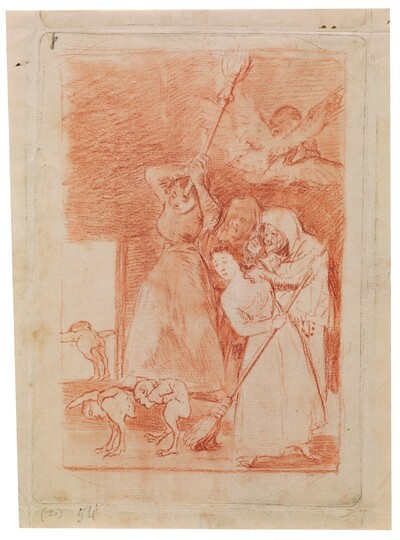- Cronología
- Ca. 1797 - 1799
- Dimensiones
- 218 x 152 mm
- Técnica y soporte
- Etching, burnished aquatint and drypoint
- Reconocimiento de la autoría de Goya
- Undisputed work
- Ficha: realización/revisión
- 29 Nov 2010 / 29 May 2024
- Inventario
- 225
They are already plucked (at the bottom).
20. (in the upper right-hand corner)
See Francisco de Goya y Lucientes, Painter.
Three state proofs with burnished aquatint and drypoint are known.
Three preparatory drawings for this engraving have survived (1), (2) and (3).
This print continues the narrative begun in the previous Caprice, No. 19, All will fall, as it depicts how, once the bird-men have been captured and plucked, they are treated with broomsticks. A young woman in the foreground pushes two of these strange beings with a broom, who defend themselves with difficulty, as if helpless. Further back, two old men, perhaps friars, although it has also been suggested that they may be procuresses, watch this scene. In the background, a young woman raises a broom over her head and prepares to crush a bird-man who is running in terror towards the background, trying to get out through a door through which the light is penetrating. In the upper right corner a bird is copulating with a bird-woman, unaware of what awaits her next.
Goya has used aquatint to achieve two tonalities which he distributes appropriately and burnishes it to produce the effect of a wash. The silhouette of the chicken at the door shows a tonal degradation of the aquatint. The rest of the hybrid creatures have been modelled with small touches of drypoint.
The manuscripts provide an interpretation for this image; the Ayala manuscript reads: "After the birds have been plucked, they are thrown out: one comes down lame and viscous, and two very reverend fathers, with their rosaries on their belts, hold their swords for them and celebrate the mockery". In the manuscript of the Prado Museum it is commented that "if they have already been plucked, go away: others will come. They will all fall". Finally, the manuscript in the National Library is more precise, stating that "after the copulation of the avechuchos, the whores throw them out with broomsticks, plucked, lame and crestfallen: two very reverend friars watch their backs, and they are the ones who celebrate with mockery with rosaries around their waists".
Prostitution became widely known in Madrid, where it was a clandestine practice, as Nicolás Fernández de Moratín, son of Leandro, an illustrious friend of the Aragonese painter, refers to it. In Chant II, page 51 of The Art of Whores, which he wrote in 1769, he states the following: "(...) in Madrid there are more than a hundred brothels because there is not a single one allowed as in other cities, which do not lose because of this; and you Madrid, you would lose nothing, but rather give less scandal that way".
In this engraving the painter develops the negative consequences of prostitution for those who resort to it, which he warned about in the previous engraving. The women, once they have been paid, expel their clients from the brothels with very bad manners. Violence is unleashed against men who have not been able to resist their instincts and who have the complicity of the two characters in the background, who are probably the promoters of this activity.
The plate is in poor condition with the aquatint notably deteriorated ( National Chalcography, no. 191).
-
El arte de GoyaMuseo de Arte Occidental de TokioTokyo1971from 16th 1971 to January 23th 1972. Exhibited also at the Kyoto Municipal Museum of Art, January 29th to March 15th 1972.cat. 64
-
Goya. Das Zeitalter der Revolucionen. Kunst um 1800 (1980 – 1981)Hamburger KunsthalleHamburg1980cat. 26a
-
Goya y el espíritu de la IlustraciónMuseo Nacional del PradoMadrid1988from October 6th to December 18th 1988. Exhibited also at Museum of Fine Arts, Boston, January 18th to March 26th 1989; The Metropolitan Museum of Art, Nueva York, May 9th to July 16th 1989, Madrid curator Manuela B. Mena Marqués, scientific directors Alfonso E. Pérez Sánchez and Eleanor A. Sayrecat. 44
-
Goya. La década de Los CaprichosMadrid1992organized by Real Academia de Bellas Artes de San Fernando sponsored by Fundación Central Hispano, Madrid, consultant editor Nigel Glendinnig. From October 26th 1992 to January 10th 1993cat. 89
-
Francisco de GoyaMuseo d'Arte ModernaLugano1996exhibition celebrated from September 22nd to November 17th.cat. 20, p.47
-
Francisco Goya. Sein leben im spiegel der graphik. Fuendetodos 1746-1828 Bordeaux. 1746-1996Galerie KornfeldBern1996from November 21st 1996 to January 1997cat. 26
-
Goya artista de su tiempo y Goya artista únicoThe National Museum of Western ArtTokyo1999from December 1st to July 3th 1999cat. 105
-
Francisco Goya. Capricci, follie e disastri della guerraSan Donato Milanese2000Opere grafiche della Fondazione Antonio Mazzottacat. 20, p.22
-
Goya e la tradizione italianaFondazione Magnani RoccaMamiano di Traversetolo (Parma)2006consultant editors Fred Licht and Simona Tosini Pizzetti. From September 9th to December 3th 2006cat. 20, p.150
-
Goya. Opera graficaPinacoteca del Castello di San GiorgioLegnano2006exhibition celebrated from December 16th 2006 to April 1st 2007p.27
-
Goya et la modernitéPinacothèque de ParisParís2013from October 11st 2013 to March 16th 2014cat. 185
-
Expérience GoyaLille2021cat. 42
-
2022
-
Goya engravings and lithographs, vol. I y II.OxfordBruno Cassirer1964p.90, cat. 55
-
Vie et ouvre de Francisco de GoyaParísOffice du livre1970p.178, cat. 491
-
Goya, la década de los caprichos: dibujos y aguafuertesMadridReal Academia de Bellas Artes de San Fernando1992pp.150-151, cat. 89
-
Catálogo de las estampas de Goya en la Biblioteca NacionalMadridMinisterio de Educación y Cultura, Biblioteca Nacional1996p.84, cat. 108
-
El libro de los caprichos: dos siglos de interpretaciones (1799-1999). Catálogo de los dibujos, pruebas de estado, láminas de cobre y estampas de la primera ediciónMadridMuseo Nacional del Prado1999pp.142-147
-
ParísPinacoteca de París2013p. 251
-
Goya. In the Norton Simon MuseumPasadenaNorton Simon Museum2016pp. 42-75
-
Expérience Goya (cat. expo)LilleRéunion des Musées Nationaux2021p. 91
-
Museo de Bellas Artes de Badajoz y Diputación de Badajoz2022p. 36



